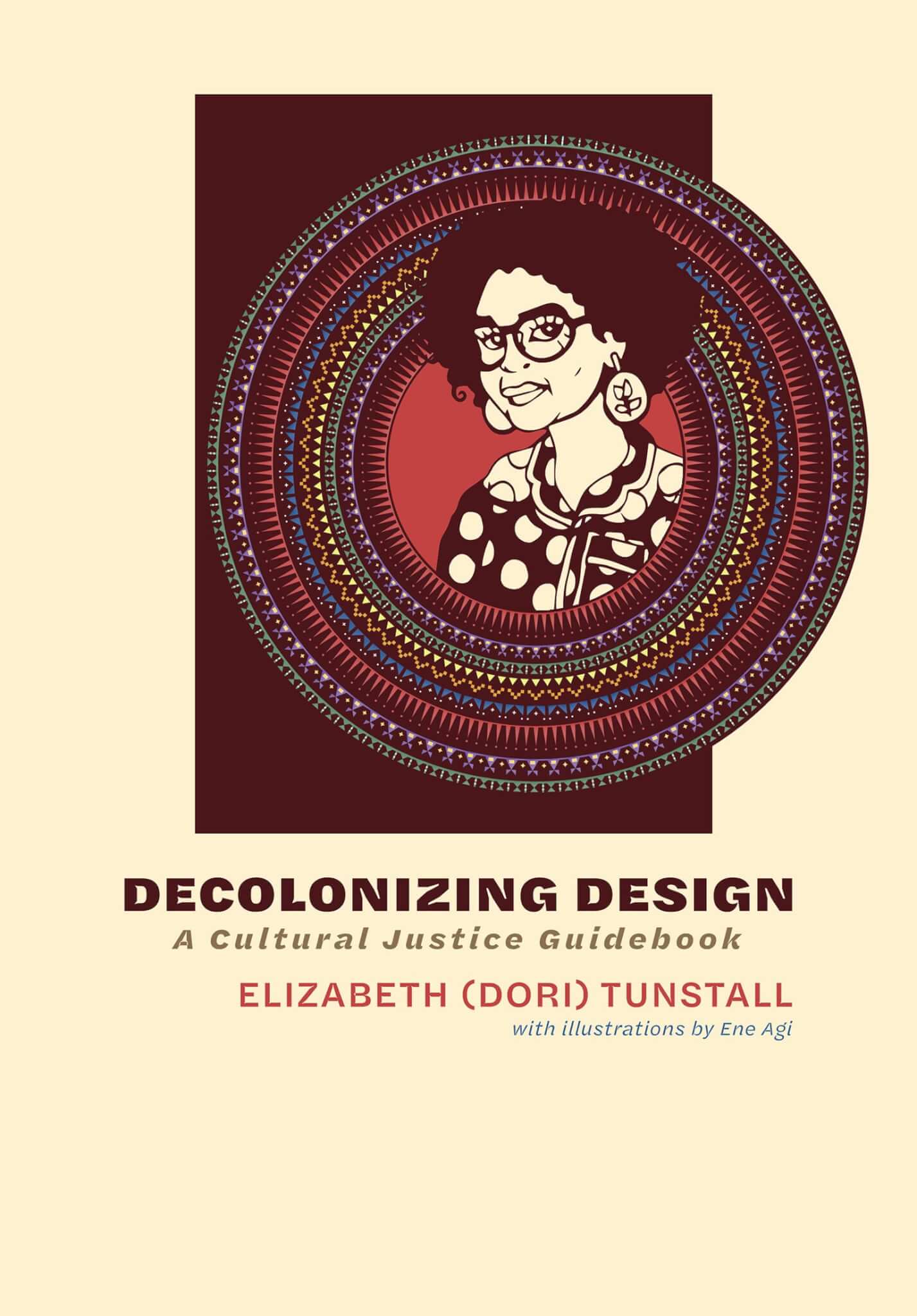Decolonizing Design: A Cultural Justice Guidebook
Elizabeth Tunstall | MIT Press | $24.95
More and better things for more people. This cheery slogan once emblazoned signage at factories owned by the U.S. automotive giant General Motors (GM) throughout apartheid South Africa. By the 1960s, the country with a 3.5 million white ruling minority and a 17.5 million non-white majority had been a source of enslaved labor and precious materials that American corporations like GM relied on to produce affordable consumer goods for decades. Indeed, the material improvements afforded to the Global North throughout the twentieth century with the rise of consumer capitalism came with a hefty price—a brutal aspect of modernity’s legacy which was largely overlooked by many twentieth century design historians.
In Decolonizing Design: A Cultural Justice Guidebook, Ontario College of Art & Design (OCAD) dean Elizabeth “Dori” Tunstall describes how the modernist project that promised better living via technological prowess was/is intricately tied to systems of oppression. “The modernist project in design tells the story that the life of everyday people improved during the 1800s through technological progress, which enabled designed things to be made cheaper and faster, thus opening more access for the working person to afford them,” Tunstall writes. “This story that we tell ourselves, whether in Fast Company or through annual design awards, is harmful because technological advances in design, whether of the 1800s or now, only make some lives better,” she says. “The better lives through technology were exclusively for European elites and, much later, for European colonial settlers… For the rest of us, better living through technology is a bad romance.”

Tunstall’s thesis question is direct: “What might decolonizing design mean to my firm/institution/organization?” This is the point of departure from which the author constructs her powerful critique of the design field’s complicated relationship with capitalism, colonialism, imperialism, white supremacy, and patriarchy. “If you are not figuring out how to eliminate the barriers to hiring Indigenous Peoples in your firm or institution, and specifically people Indigenous to wherever you are located, then you are not engaging in decolonization.” For Tunstall, “decolonization means ceding the power of decision making to the original peoples of the land.”
On Blacksquares, DEI, and Supertokens
In 2016, Tunstall became the first Black female dean of OCAD University in Toronto, a first in the school’s history and for design programs throughout North America. Following her appointment, Tunstall helped secure the first Black cluster hire in the school’s 144-year existence. (OCAD University’s Open Call for Black Applicants in the Faculty of Design went viral upon its release in June 2020.) While her deanship was an important step forward, Tunstall notes in her new book that real equality in design demands much more than just visibility and representation for Indigenous, Black, and People of Color (IBPOC).

Illuminated with beautiful illustrations by artist Ene Agi, in Decolonizing Design Tunstall pushes back against widespread liberal consensus about what equality really means. The author calls attention to practices like supertokenism, or when individuals “from marginalized group(s) whose talents are so desired by institutions that they are able to overcome their innate aversion to the individual’s identities in order to have access to those talents,” Tunstall writes. “Seeking a supertoken might bring surface diversity but not necessarily inclusion, and definitely not decolonization. The supertoken exists because they have excelled in systems that were meant to crush them. Their presence in a firm or institution does not automatically change the system,” she writes. “In some cases, the supertoken might be the one upholding the system with an ‘I made it through, why can’t you’ attitude.”
In Decolonizing Design, Tunstall also confronts the assumption that Diversity, Equity, and Inclusion (DEI) campaigns at firms, institutions and universities are the penultimate path to equality they’ve been made out to be—mostly by white interlocutors—instead vying for real structural change in socioeconomic relations for IBPOC. Written as a literal guidebook, Tunstall’s text offers clear steps for institutions to follow to “make amends for the colonial racism and systemic exclusion” in design. Decolonizing Design argues that decolonizing design is a long-term project based on five points; and above all, centering Indigenous perspectives and demands while striving for reparations. It also means dismantling the “tech” and “racist bias in the European modernist project,” “making amends through more than DEI,” and “reprioritizing existing resources to decolonize.” The book itself is divided into five chapters—one for each point. The thread that ties them all together is that the “modernist project in design excludes Indigenous, Black, Asian, Middle Eastern, and Latinx bodies.”
Towards Design Reparations
Design, according to Tunstall, as it’s been practiced since industrialization through the Bauhaus until today, created a world in the “universal” man’s image, a figure propagated by the likes of Le Corbusier, Walter Gropius, Mies van der Rohe, and the Nazi Johannes Itten. [For more on this, look at Itten’s 1921 project House of the White Man.] For these problematic design demigods, the universal man connoted the “everyman” that designers should try to make life better for, not ruling elites like it had since the days of monarchy. As Tunstall points out, however, the Bauhaus’s universal man wasn’t truly universal, rather “white, cis-male, Anglo-Saxon, Christian, heterosexual, affluent, and of able body and mind,” she says. “Anyone who deviates from this model is asked to assimilate to becoming that figure.” Her thesis argues in part that such design thinking created a society that works great for one extremely narrow subset of human being while everyone else foots the bill.
Tunstall shows how modernist design alienates by describing her own lived experiences in Chicago, a city she argues is “a tangible embodiment of the modernist project in design.” Following an overview of the city’s long problematic history of expositions and world’s fairs, the author talks about her own personal experiences negotiating with racist landlords, and the city’s blatant segregation by race and class lines; phenomena she argues are implicit to the modern project by design. “The city beckons with romantic promises that if you come to the bright lights of the Big City, you can live a life of more convenience, more comfort, more wealth, and more glamor,” she writes. “Just ignore the poverty, the discrimination and segregation, the old, and the corruption, which is part of the modernist project in design as well.”
In turn, Decolonizing Design asks “how design can help repair the damage that design has caused?” an act which Tunstall says can be amended through design reparations. In the book’s last chapter, Tunstall quantifies the financial debt settler-colonial states owe Indigenous people, describing the “unpayable debt” between U.S. and Canadian governments and those that were violently displaced by them. “Even if we know our debt is limitless, how do we begin to pay, especially if we do not have a lot of resources?” Tunstall asks in her impassioned plea for designers to help right this wrong.
Much of the thinking that went into Decolonizing Design stemmed from a lecture Tunstall delivered at the Museum of Modern Art (MoMA) in 2019. At MoMA, Tunstall elected to discuss the reparations work happening at OCAD University. She also used her platform to usher in a call for action to help raise $600,000 per year for annual Black cluster hires; a prompt which wasn’t met that day by MoMA’s wealthy patrons but nevertheless showed its audience that equity is fundamentally tied to economics. In its conclusion, there are actionable directions for helping IBPOC educators. These include strategies for budget reappropriation, rhetoric for convincing a rigid administration to change its old ways of doing things, and how to write more inclusive job descriptions.
More broadly, Decolonizing Design sheds light on potential pitfalls one may face in their own journey decolonizing institutions. Drawing from personal experiences, Tunstall confides in readers that she herself made mistakes in negotiations with Indigenous groups in Toronto when OCAD University was in the early throes of decolonization work. “I make mistakes, admit them, ask what I can do to make amends, and then do the work required of me,” Tunstall says. Paraphrasing Toni Morrison, Tunstall says the book is one she “wanted to read but hadn’t written yet.”
Dan Jonas-Roche is a lecturer at Kean University School of Public Architecture. He lives in New York City.











